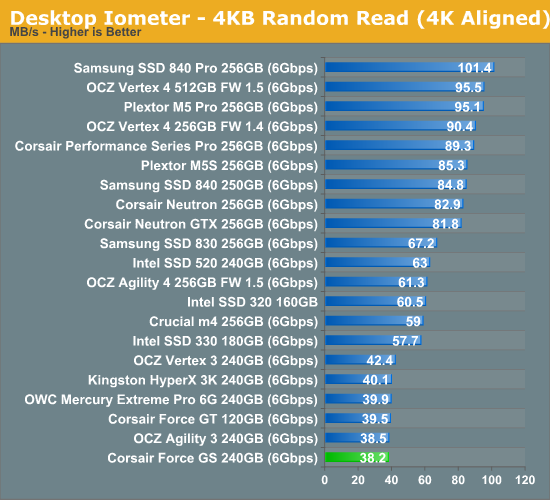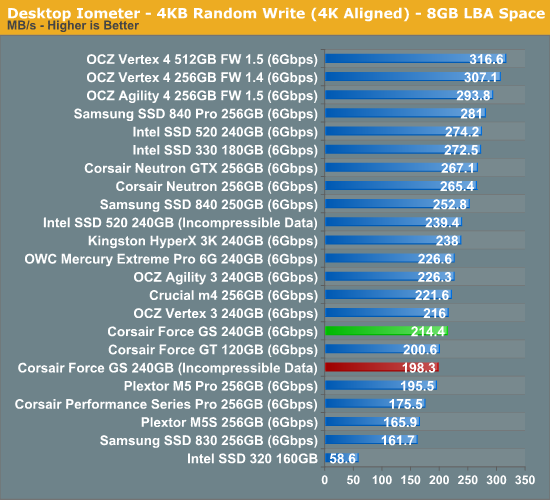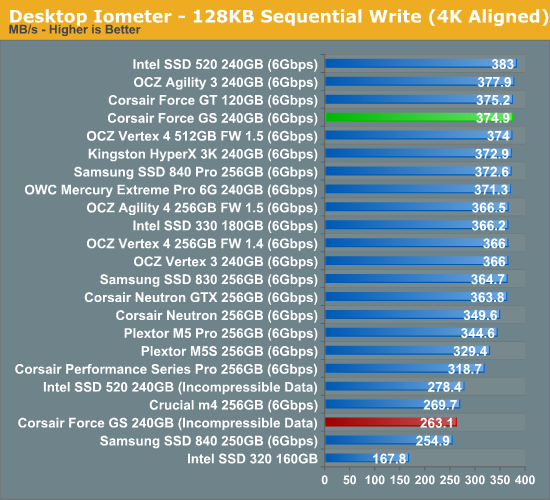SandForce TRIM Issue & Corsair Force Series GS (240GB) Review
by Kristian Vättö on November 22, 2012 1:00 PM ESTRandom Read/Write Speed
The four corners of SSD performance are as follows: random read, random write, sequential read and sequential write speed. Random accesses are generally small in size, while sequential accesses tend to be larger and thus we have the four Iometer tests we use in all of our reviews. Our first test writes 4KB in a completely random pattern over an 8GB space of the drive to simulate the sort of random access that you'd see on an OS drive (even this is more stressful than a normal desktop user would see).
We perform three concurrent IOs and run the test for 3 minutes. The results reported are in average MB/s over the entire time. We use both standard pseudo randomly generated data for each write as well as fully random data to show you both the maximum and minimum performance offered by SandForce based drives in these tests. The average performance of SF drives will likely be somewhere in between the two values for each drive you see in the graphs. For an understanding of why this matters, read our original SandForce article.

Random read speed has never been SandForce's strength and the Force GS is no exception. Real-time compression doesn't provide much benefit to read performance because reading from NAND has always been much faster than programming. Presumably SandForce's third generation controllers (SF-3000) will address random read and write performance, although it's way too early to tell how big of improvements we should expect.


Random write performance is exceptionally low. At queue depth of 3 (the first random write graph), the Force GS manages to stay roughly on-par with other SF-2281 based SSDs, but at queue depth of 32 there is a more noticeable difference. While we are only talking about a difference of a few percents, it's still surprising that the Force GT doesn't achieve speeds similar to other SF-2281 SSDs.
Sequential Read/Write Speed
To measure sequential performance we ran a one minute long 128KB sequential test over the entire span of the drive at a queue depth of 1. The results reported are in average MB/s over the entire test length.


Sequential performance is typical SandForce. With highly compressible data, SandForce SSDs are still the fastest in sequential write speed, although OCZ Vertex 4 is getting very close.










56 Comments
View All Comments
JellyRoll - Saturday, November 24, 2012 - link
Entertaining that you would link to thessdreview, which is pretty much unanimously known as the home of misinformation. Here is a link to the actual slide deck from that presentation, which does not ever mention deduplication.http://www.flashmemorysummit.com/English/Collatera...
CeriseCogburn - Saturday, December 29, 2012 - link
LOL - good job, I will continue to read and see if all the "smart" people have finally shut the H up.I was hoping one would come by, apologize, and thank you.
Of course I know better.
*Happy the consensus is NOT the final word.*
dishayu - Friday, November 23, 2012 - link
Get Kristian on to the next episode of the podcast and make him talk!!popej - Friday, November 23, 2012 - link
What exactly does it mean: "I TRIM'ed the drive after our 20 minute torture"?Shouldn't TRIM function be executed by OS all the time during torture test?
Kristian Vättö - Friday, November 23, 2012 - link
Most of our tests are run without a partition, meaning that the OS has no access to the drive. After the torture, I created a partition which formats the drive and then deleted it. Formatting the drive is the same as TRIMing all user-accessible LBAs since it basically tells the controller to get rid of all data in the drive.popej - Friday, November 23, 2012 - link
Does it mean, that there was no TRIM command executed at all?Not when torturing drive, because it wasn't TRIM supported partition. Not when you "TRIM'ed" drive, because it was a format.
While I agree that you can notice some weird effects, why do you describe them as TRIM problems? Sorry, but I don't know how your test could be relevant to standard use of SDD, when TRIM is active all the time.
Kristian Vättö - Friday, November 23, 2012 - link
Formatting is the same as issuing a TRIM command to the whole drive. If I disable TRIM and format the drive, its performance won't restore since the drive still thinks the data is in use and hence you'll have to do read-modify-write when writing to the drive.They are problems in the sense that the performance should fully restore after formatting. If it doesn't, then TRIM does not function properly. Using an extreme scenario like we do it the best for checking if there is a problem; how that affects real world usage is another question. With light usage there shouldn't be a problem but you may notice the degradation in performance if your usage is write intensive.
popej - Friday, November 23, 2012 - link
Basing on you test I would say, that format is not enough to restore drive performance after using it without TRIM. Quite possible that the state of the drive after torture without TRIM is very different to anything you can get when TRIM is active.It would be interesting to compare your test to real life scenario, with NTFS partition and working TRIM.
Kristian Vättö - Friday, November 23, 2012 - link
With most SSDs, formatting the drive will fully restore it's performance, so the behavior we're seeing here is not completely normal.Remember that even if TRIM is active at all times, sending a TRIM command to the controller does not mean the data will be erased immediately. If you're constantly writing to the SSD, the controller may not have time to do garbage collection in real time and hence the SSD may be pushed to a very fragmented state as in our test where, as we can see, TRIM doesn't work perfectly.
I know that our test may not translate to real world in most cases, but it's still a possible scenario if the drive is hammered enough.
JellyRoll - Friday, November 23, 2012 - link
If the majority of your tests are conducted without a partition that means none of the storage bench results are with TRIM?